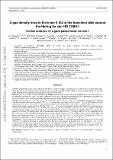A gas density drop in the inner 6 AU of the transition disk around the Herbig Ae star HD 139614 : Further evidence for a giant planet inside the disk?
Abstract
Context. Quantifying the gas surface density inside the dust cavities and gaps of transition disks is important to establish their origin. Aims. We seek to constrain the surface density of warm gas in the inner disk of HD 139614, an accreting 9 Myr Herbig Ae star with a (pre-)transition disk exhibiting a dust gap from 2.30.1 to 5.60.3 AU. Methods. We observed HD 139614 with ESO/VLT CRIRES and obtained high-resolution (R~90 000) spectra of CO isotopologues ro-vibrational emission at 4.7 μm. We derive constraints on the disk’s structure by modeling the CO isotopologue line profiles, the spectroastrometric signal, and the rotational diagrams using grids of flat Keplerian disk models. Results. We detected v = 1 → 0 12CO, 2→1 12CO, 1→0 13CO, 1→0 C18O, and 1→0 C17O ro-vibrational lines. Lines are consistent with disk emission and thermal excitation. 12CO v = 1→ 0 lines have an average width of 14 km s-1, Tgas of 450 K and an emitting region from 1 to 15 AU. 13CO and C18O lines are on average 70 and 100 K colder, 1 and 4 km s-1 narrower than 12CO v = 1→ 0, and are dominated by emission at R ≥ 6 AU. The 12CO = 1 → 0 composite line profile indicates that if there is a gap devoid of gas it must have a width narrower than 2 AU. We find that a drop in the gas surface density (δgas) at R = 5 — 6 AU is required to be able to reproduce the line profiles and rotational diagrams of the three CO isotopologues simultaneously. Models without a gas density drop generate 13CO and C18O emission lines that are too broad and warm. The value of gas can range from 10-2 to 10-4 depending on the gas-to-dust ratio of the outer disk. We find that the gas surface density profile at 1 < R < 6 AU is flat or increases with radius. We derive a gas column density at 1 < R < 6 AU of NH = 5 1019 - 1021 cm-2 (1.2 × 10-4 × 2.4 10-3 g cm-2) assuming NCO = 10-4NH. We find a 5σ upper limit on the CO column density NCO at R≤1 AU of 5 × 1015 cm-2 (NH ≤ 5 × 1019 cm-2). Conclusions: The dust gap in the disk of HD 139614 has molecular gas. The distribution and amount of gas at R≤ 6 AU in HD 139614 is very different from that of a primordial disk. The gas surface density in the disk at R ≤ 1 AU and at 1 < R < 6 AU is significantly lower than the surface density that would be expected from HD 139614’s accretion rate (10-8 M yr-1) assuming a standard viscous α-disk model. The gas density drop, the non-negative density gradient in the gas inside 6 AU, and the absence of a wide (> 2 AU) gas gap suggest the presence of an embedded < 2 MJ planet at around 4 AU.
Citation
Carmona , A , Thi , W F , Kamp , I , Baruteau , C , Matter , A , van den Ancker , M , Pinte , C , Kóspál , A , Audard , M , Liebhart , A , Sicilia-Aguilar , A , Pinilla , P , Regály , Z , Güdel , M , Henning , T , Cieza , L A , Baldovin-Saavedra , C , Meeus , G & Eiroa , C 2017 , ' A gas density drop in the inner 6 AU of the transition disk around the Herbig Ae star HD 139614 : Further evidence for a giant planet inside the disk? ' , Astronomy & Astrophysics , vol. 598 , A118 . https://doi.org/10.1051/0004-6361/201628472
Publication
Astronomy & Astrophysics
Status
Peer reviewed
ISSN
0004-6361Type
Journal article
Description
A. Carmona was partly supported by the Spanish Grant AYA 2011-26202. A. Carmona, A. Kospal and Zs. Regaly were partly supported by the Momentum grant of the MTA CSFK Lendulet Disk Research Group of the Hungarian Academy of Sciences. A. Carmona and C. Pinte acknowledge funding from the European Commission’s 7th Framework Program (ECFP7) (contract PERG06-GA-2009-256513) and from Agence Nationale pour la Recherche (ANR) of France under contract ANR-2010-JCJC-0504-01. A. Carmona acknowledges financial support by the European Southern Observatory visitors program. The research leading to these results has received funding from the EC-FP7 under grant agreement no 284405. C. Eiroa is partly supported by the Spanish Grant AYA 2014-55840-P L. A. Cieza was supported by CONICYT-FONDECYT grant number 1140109 and the Millennium Science Initiative (Chilean Ministry of Economy), through grant Nucleus RC130007.Collections
Items in the St Andrews Research Repository are protected by copyright, with all rights reserved, unless otherwise indicated.

